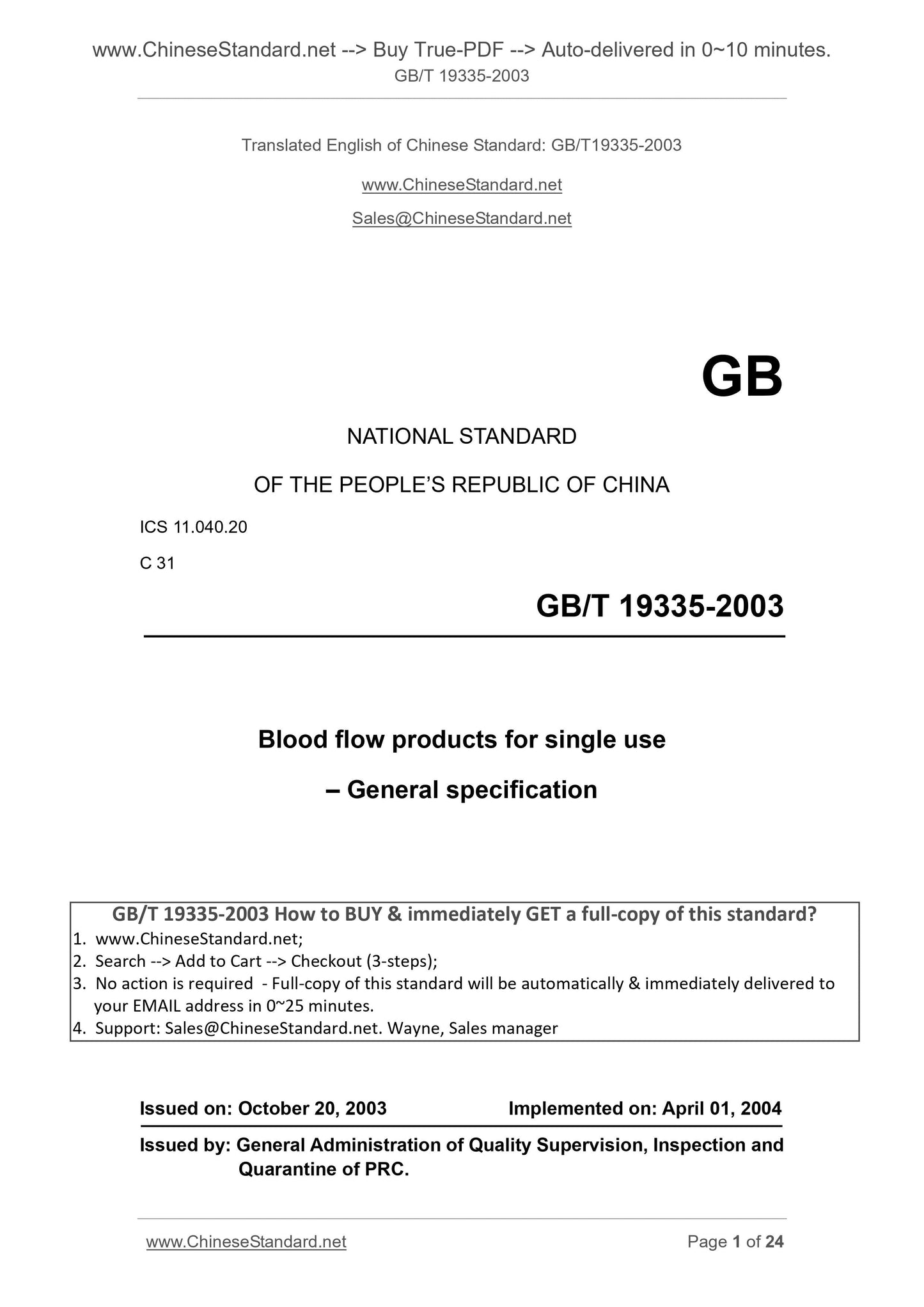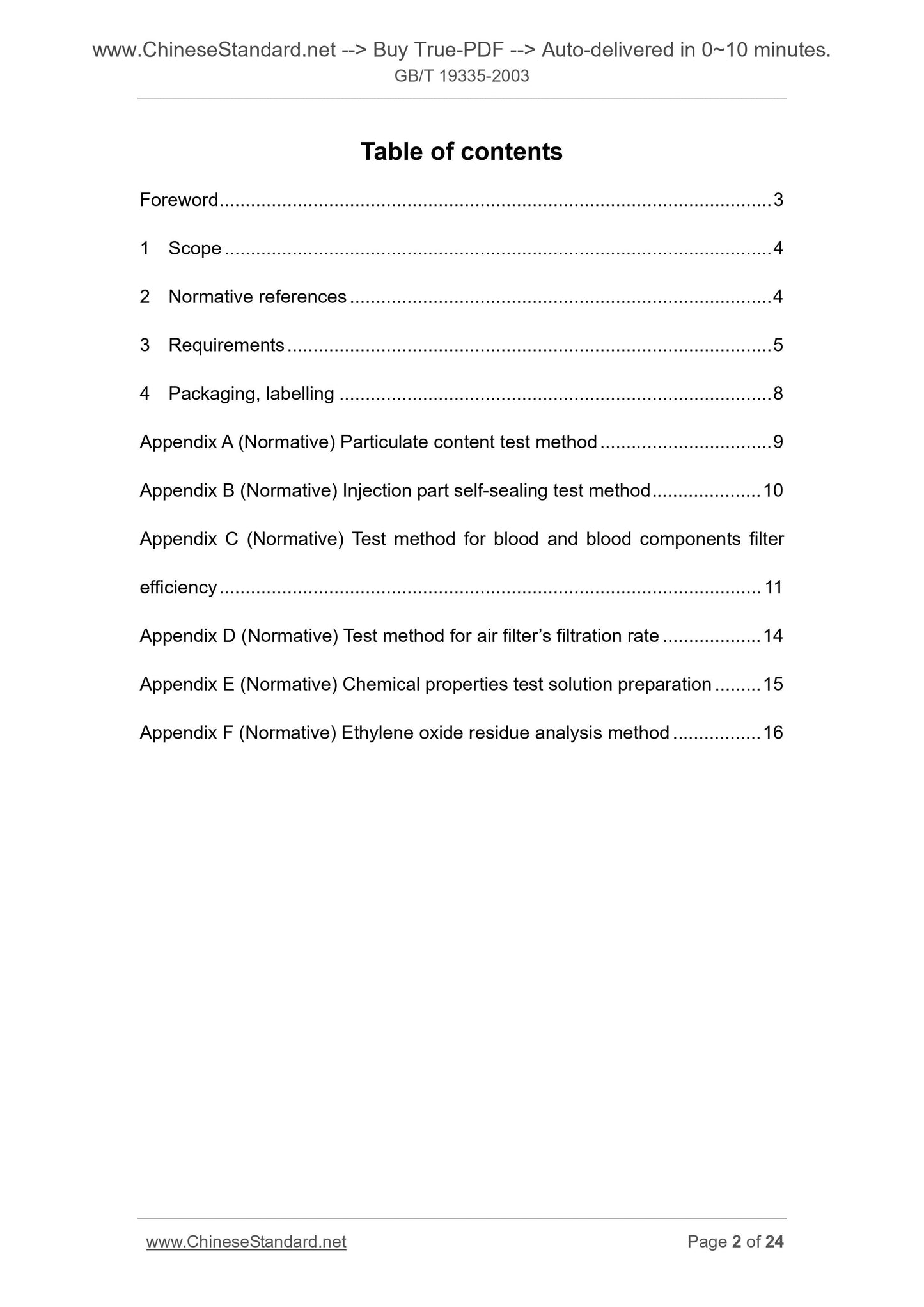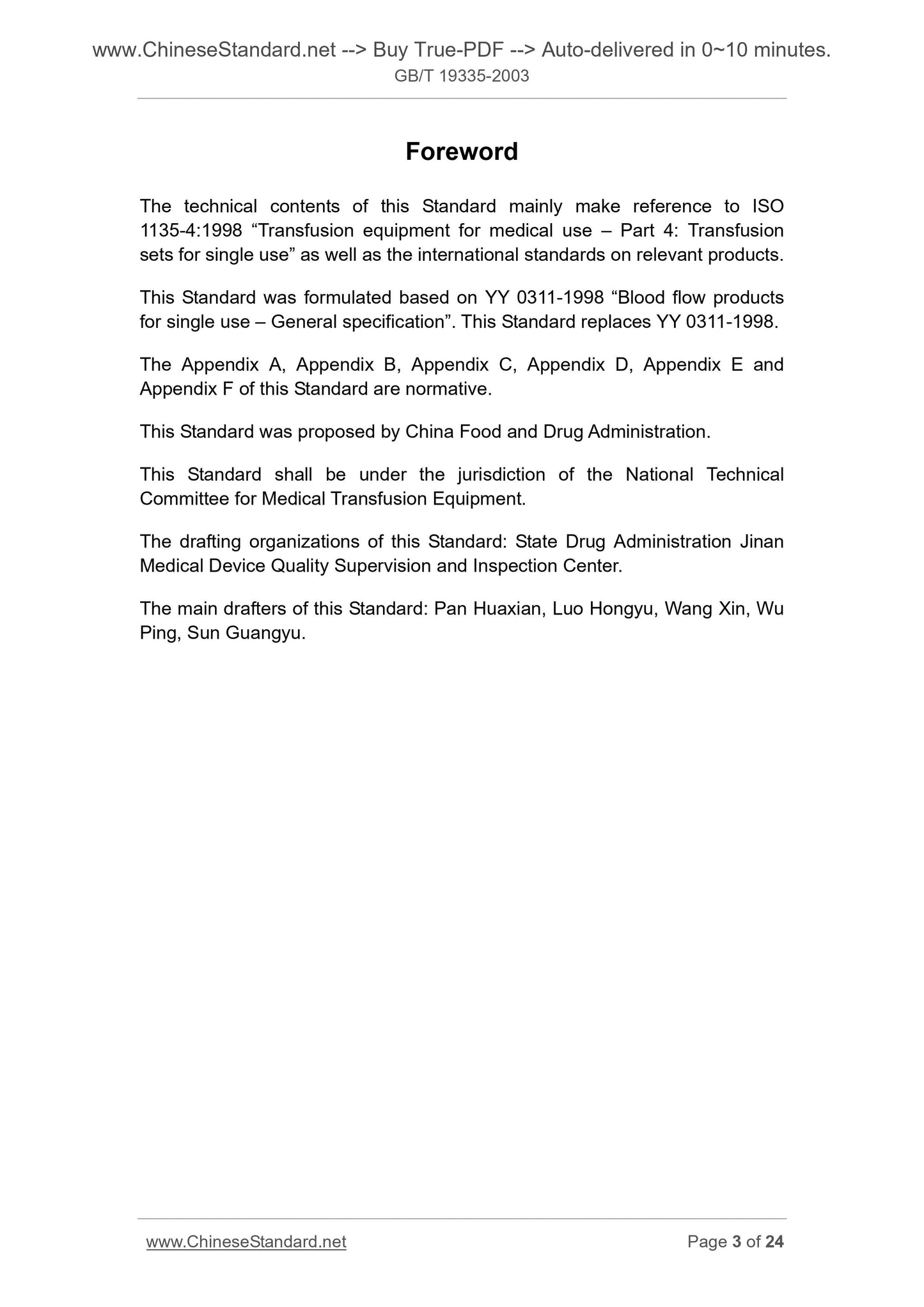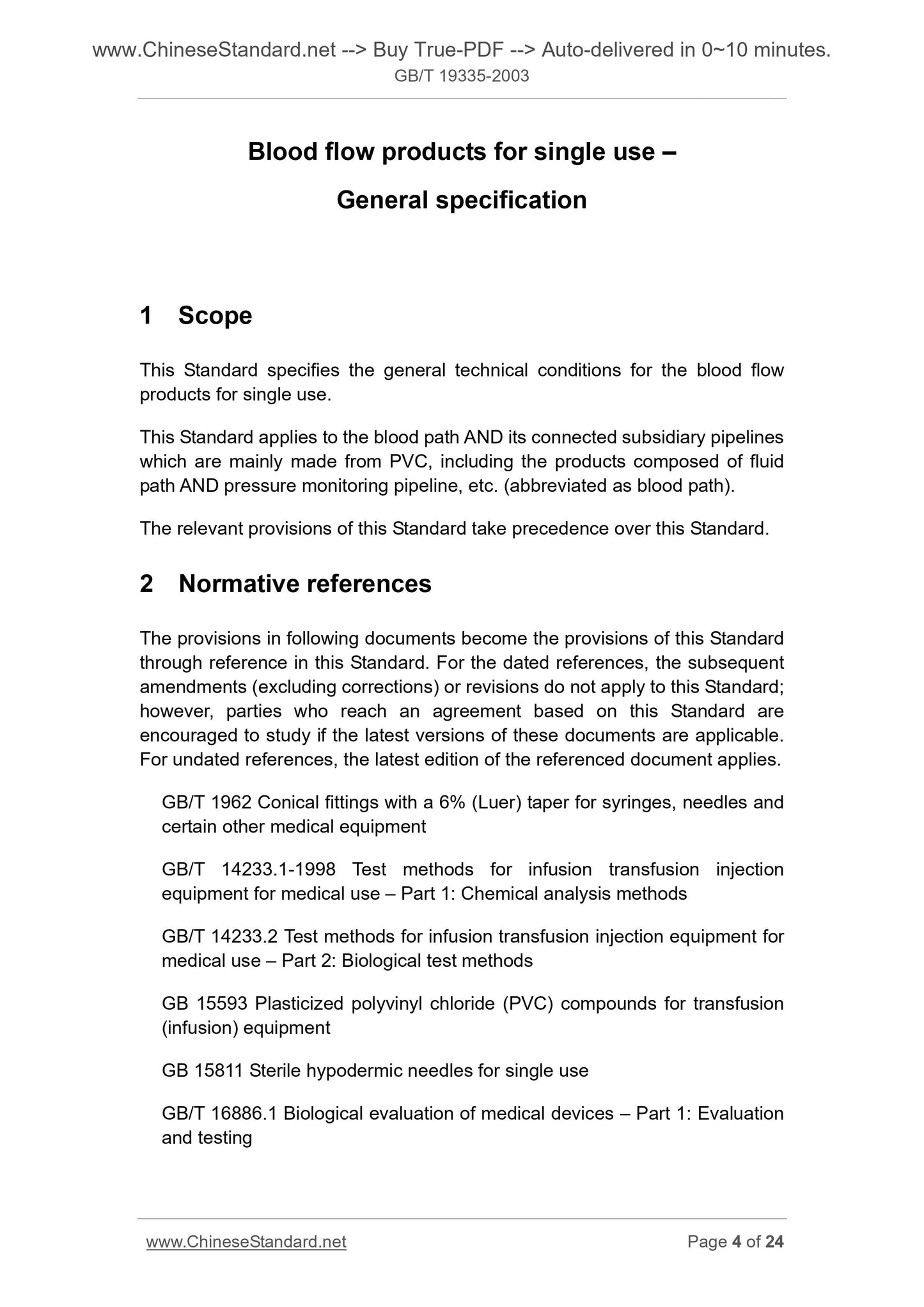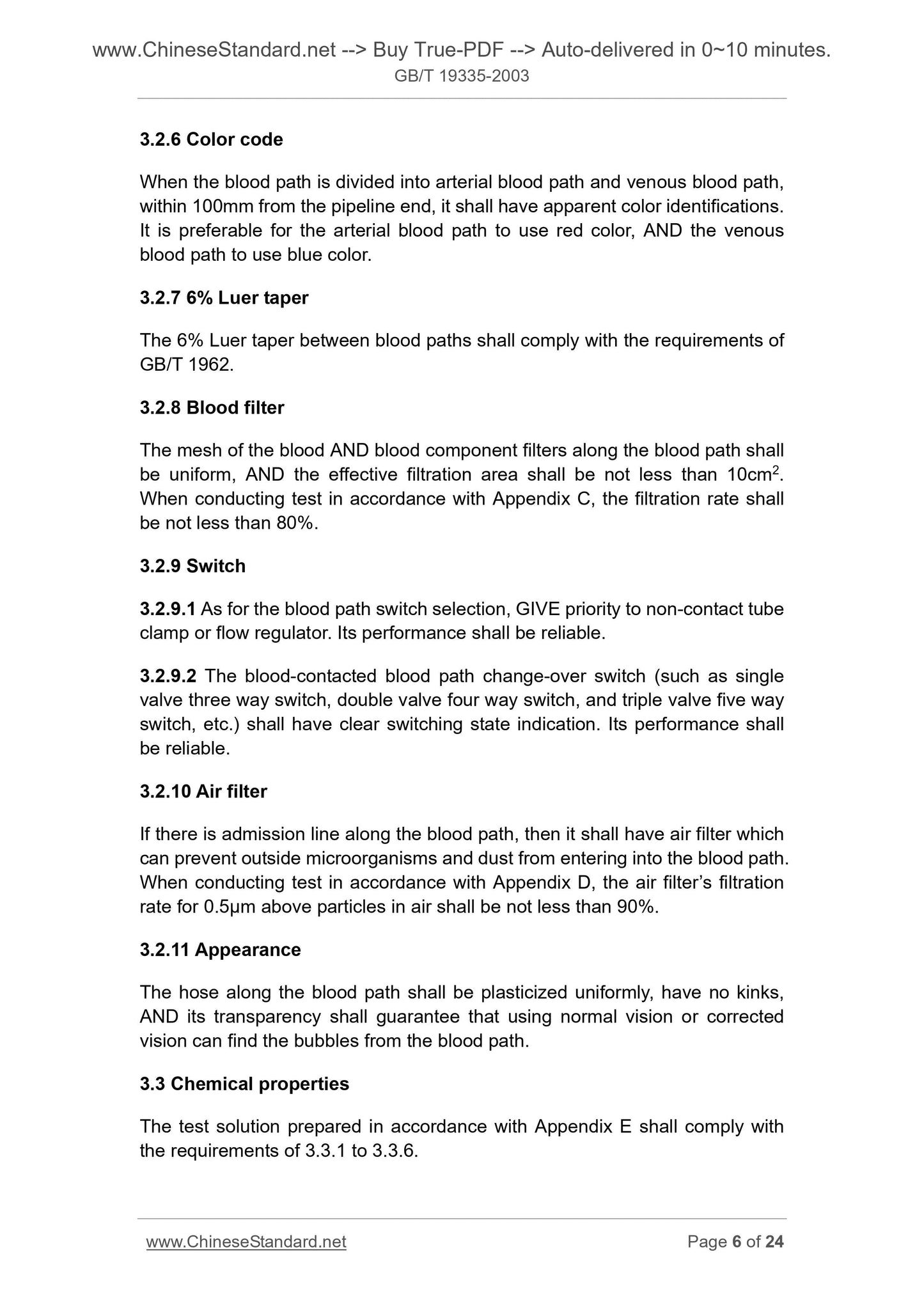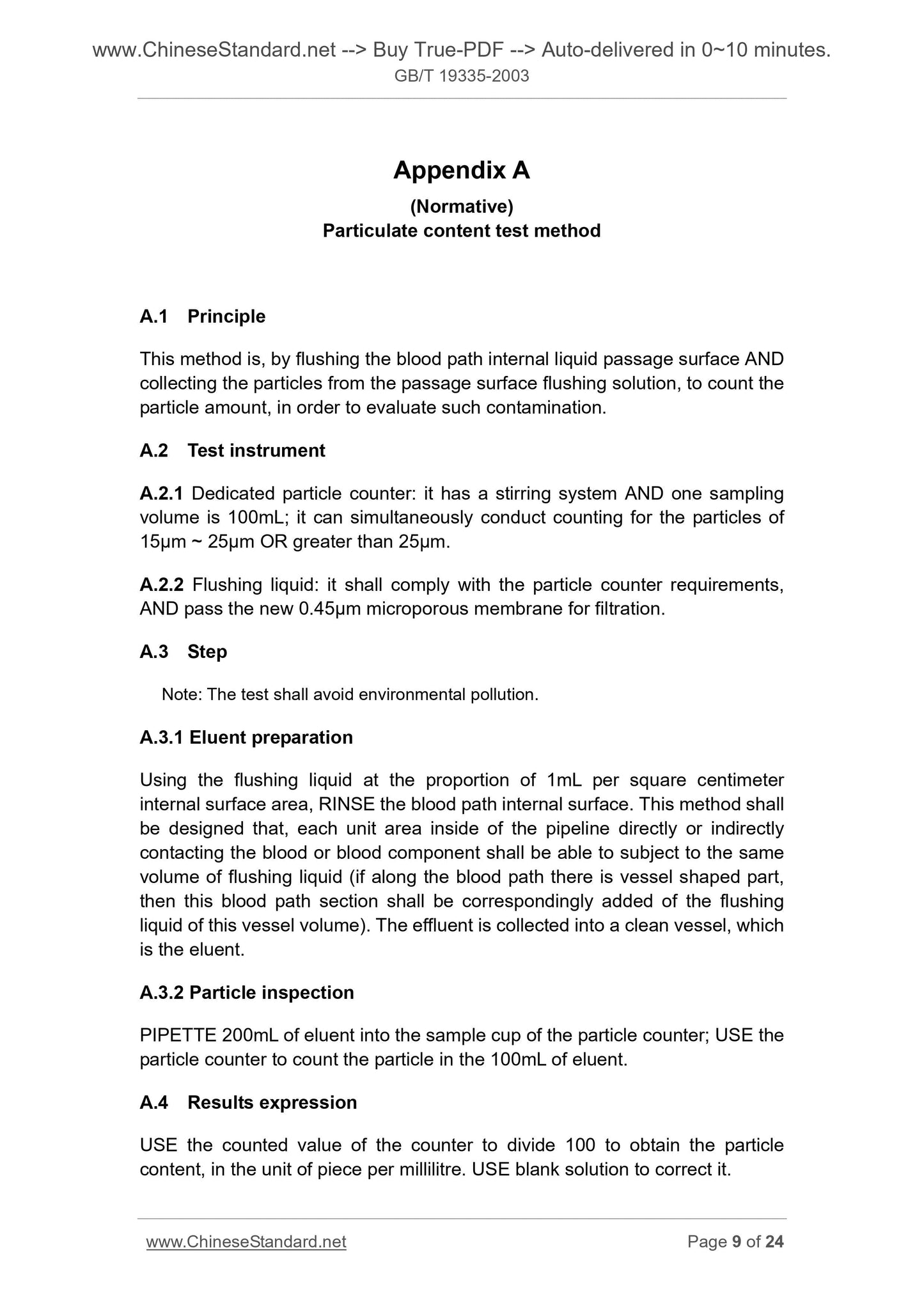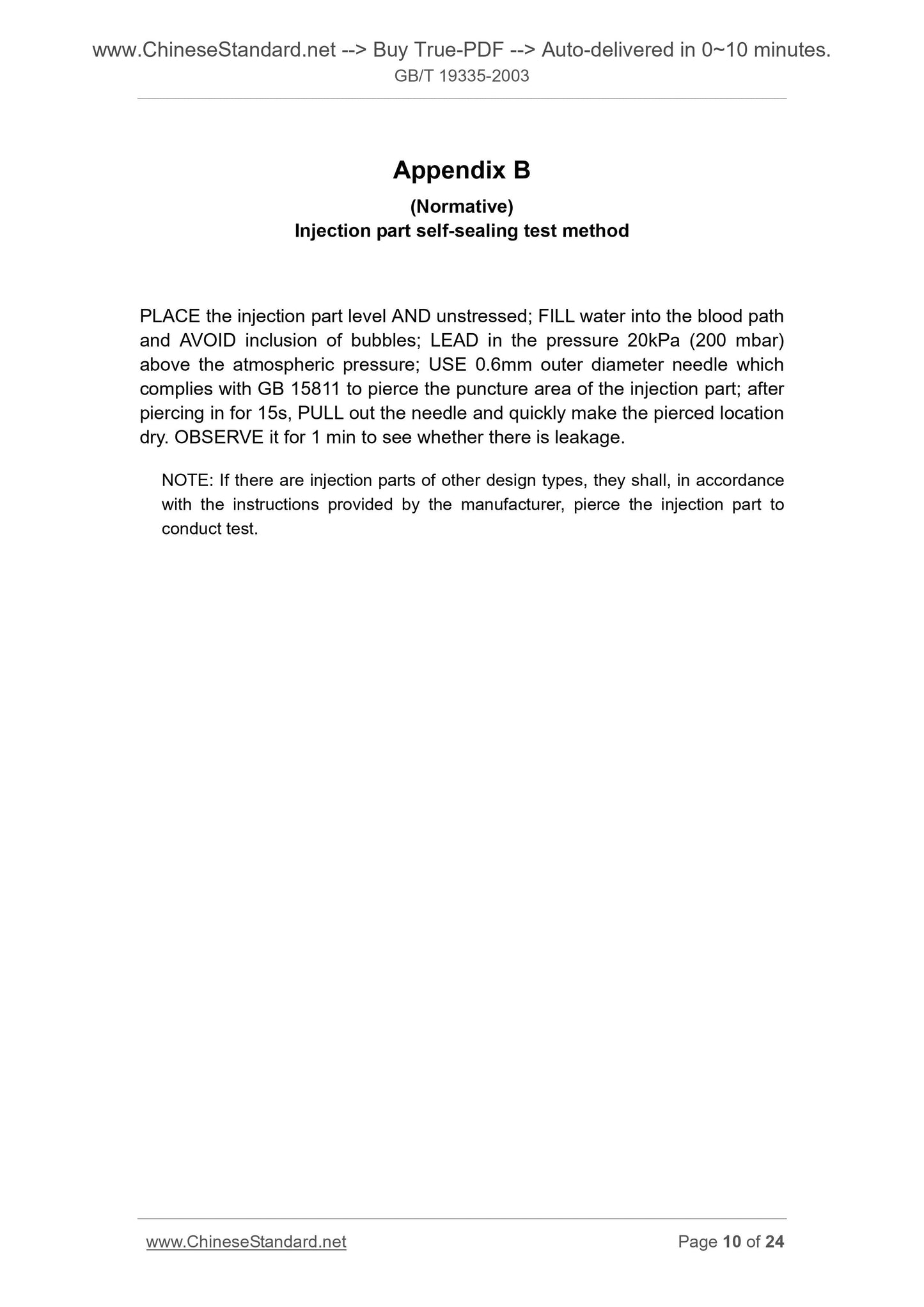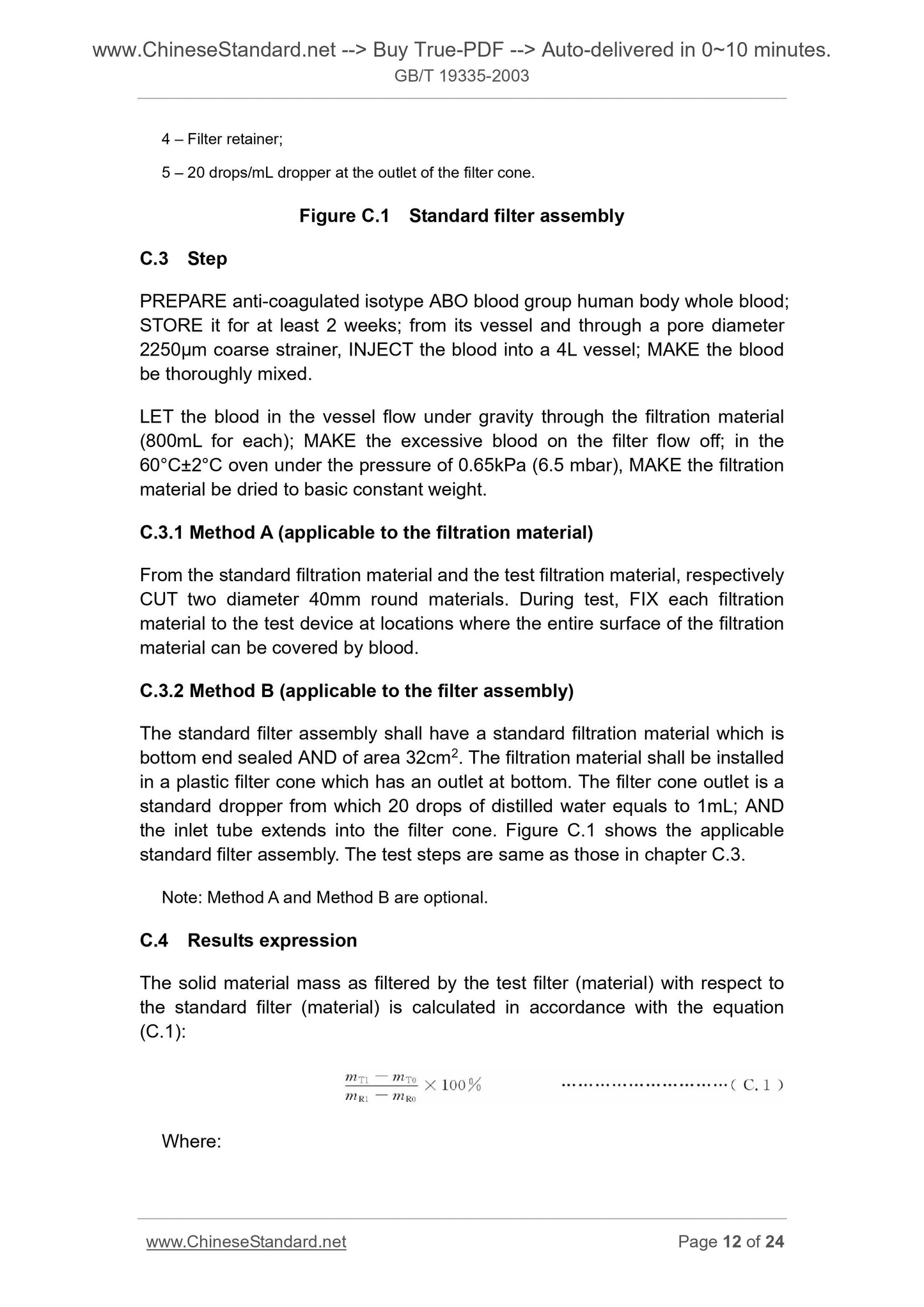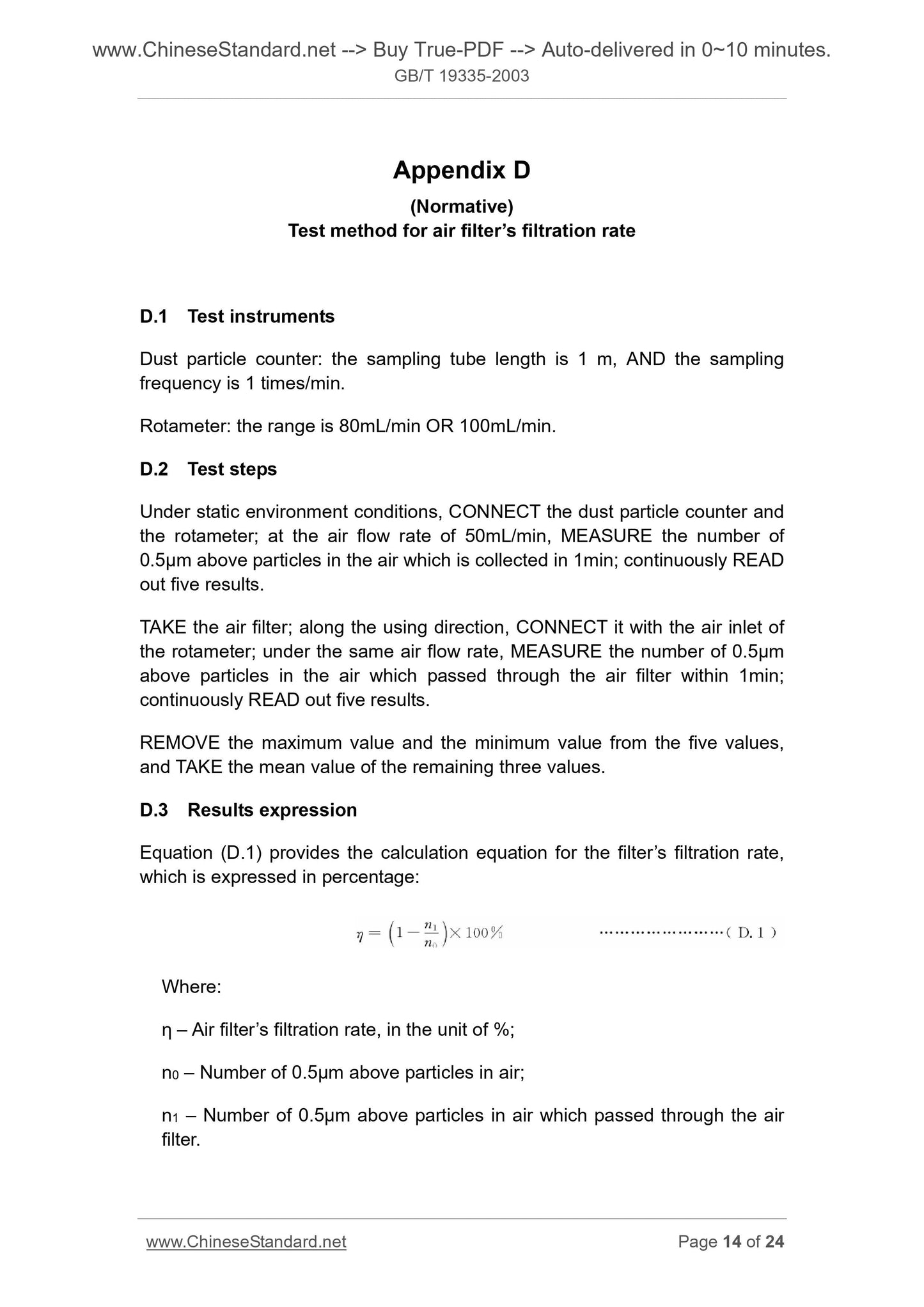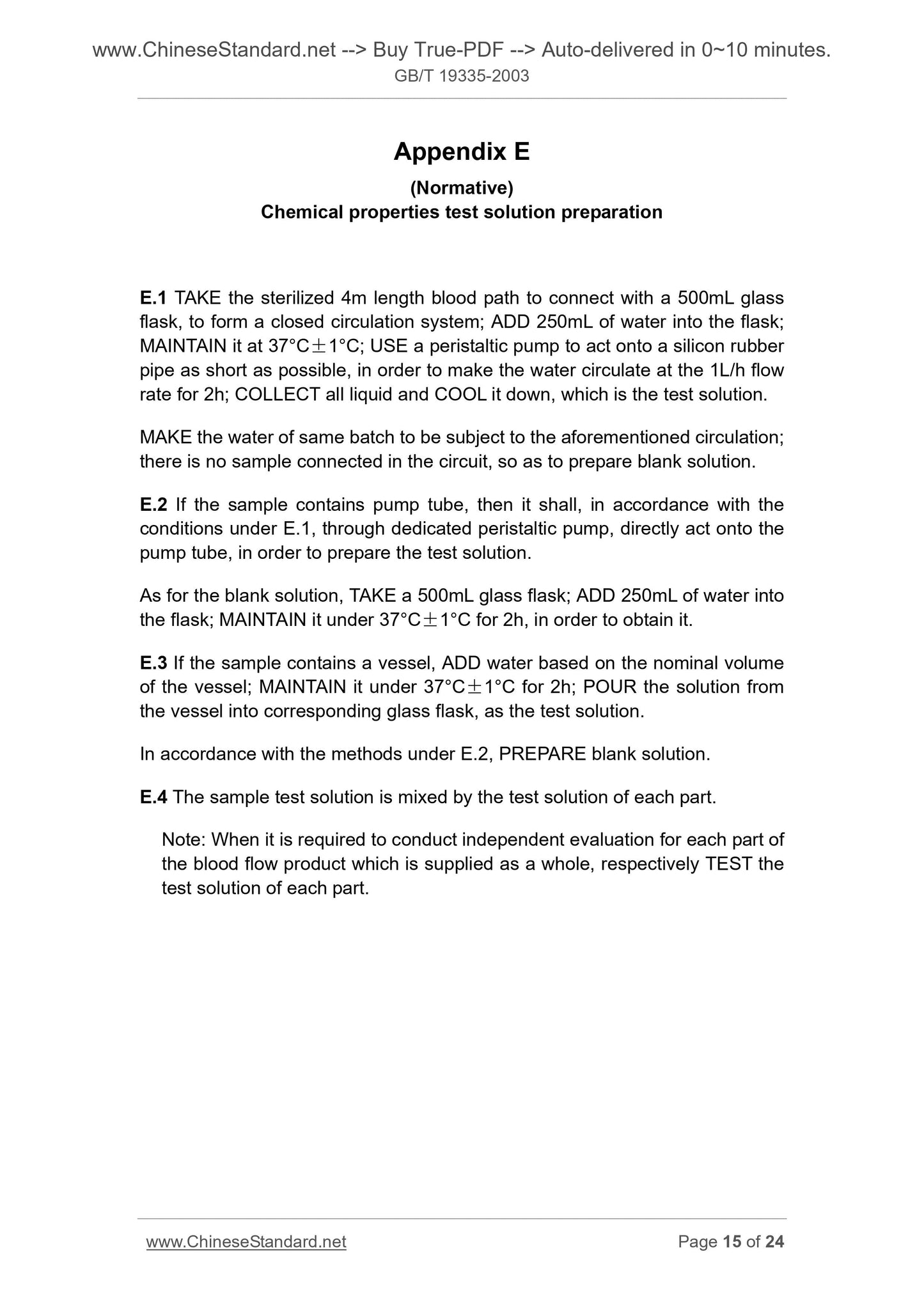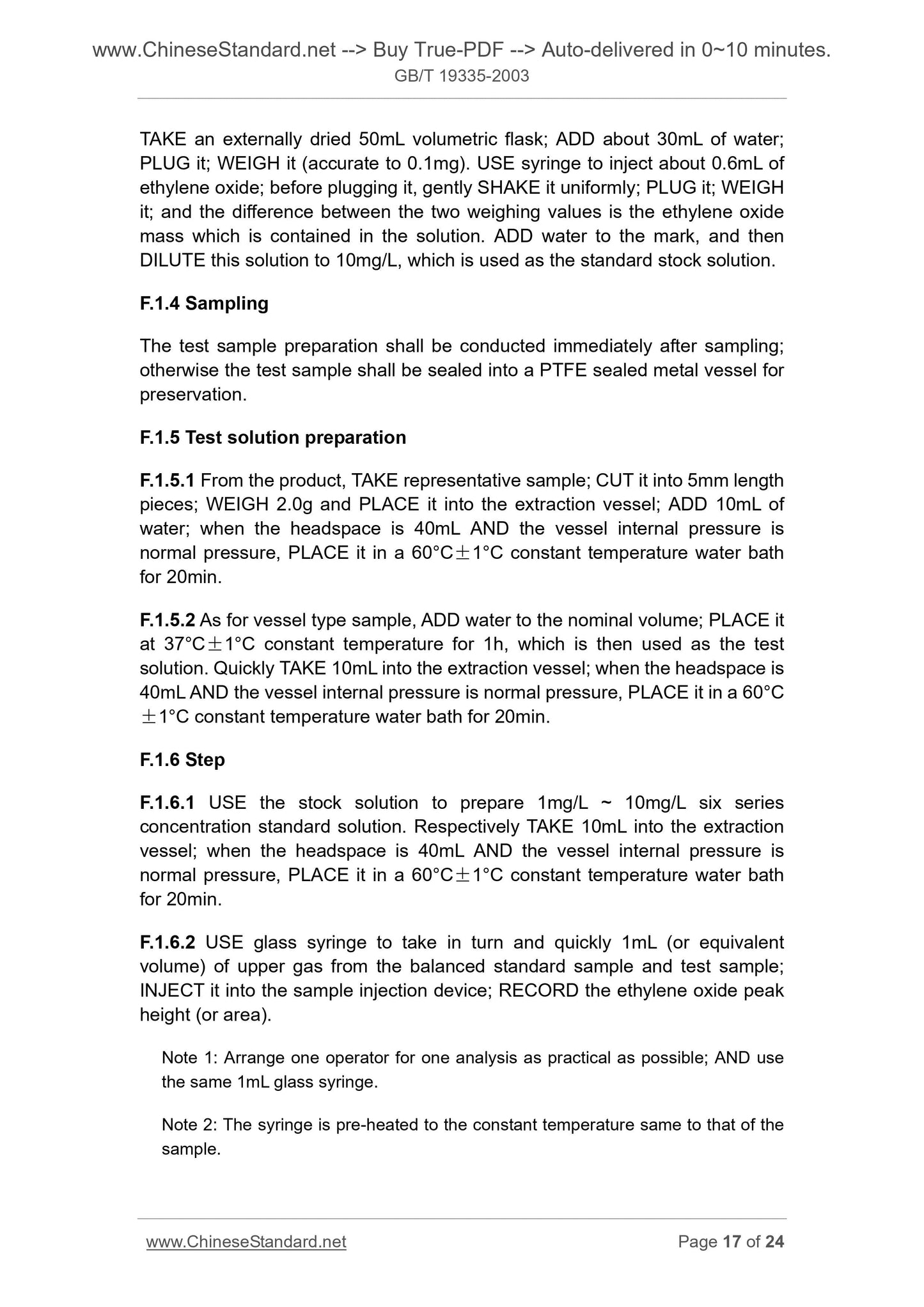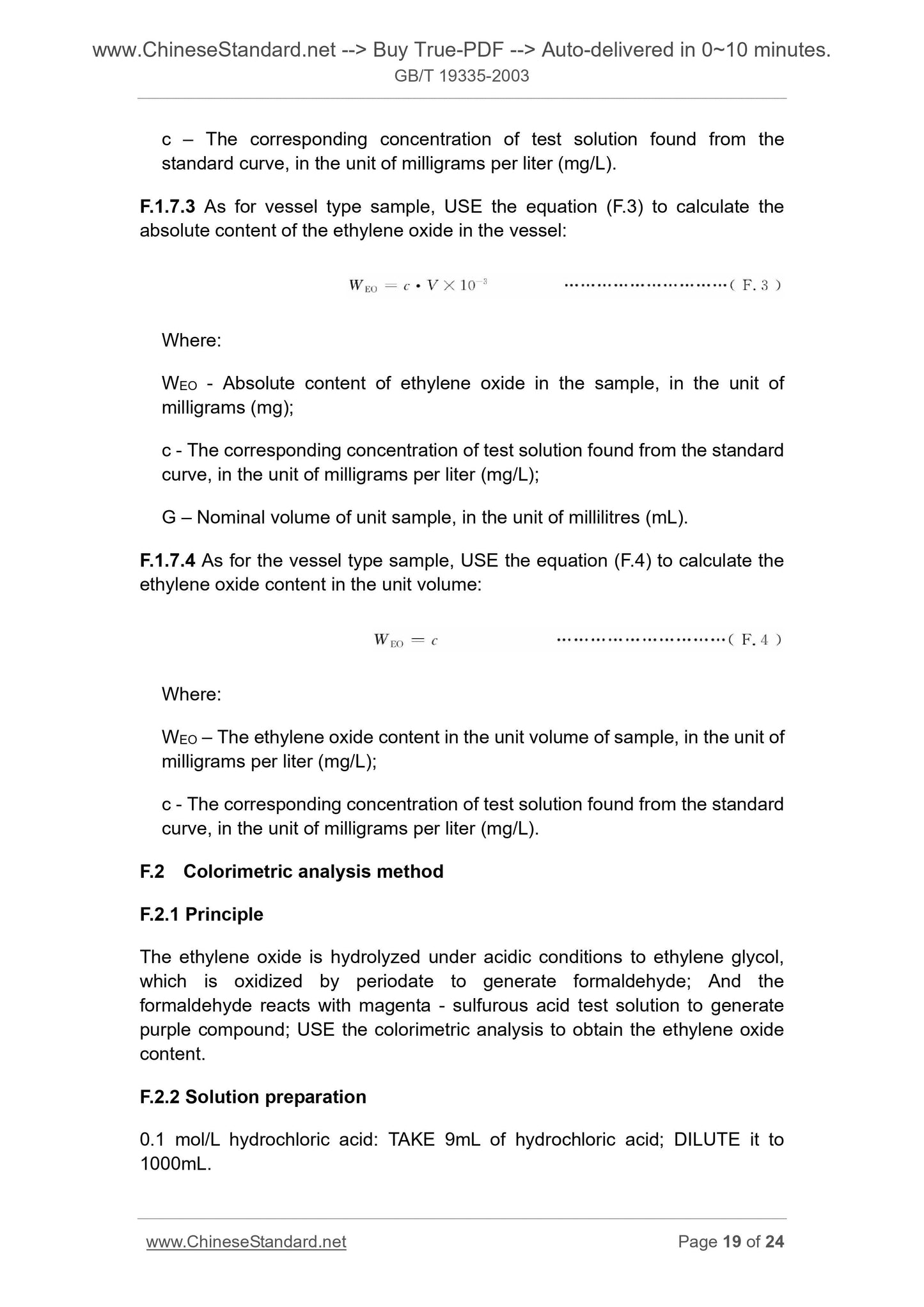1
/
of
12
PayPal, credit cards. Download editable-PDF & invoice in 1 second!
GB 19335-2003 English PDF (GB19335-2003)
GB 19335-2003 English PDF (GB19335-2003)
Regular price
$125.00 USD
Regular price
Sale price
$125.00 USD
Unit price
/
per
Shipping calculated at checkout.
Couldn't load pickup availability
Delivery: 3 seconds. Download true-PDF + Invoice.Newer version: (Replacing this standard) GB/T 19335-2022
Get QUOTATION in 1-minute: Click GB 19335-2003
Historical versions: GB 19335-2003
Preview True-PDF (Reload/Scroll if blank)
GB 19335-2003: Blood flow products for single use -- General specification
GB/T 19335-2003
GB
NATIONAL STANDARD
OF THE PEOPLE’S REPUBLIC OF CHINA
ICS 11.040.20
C 31
Blood flow products for single use –
General specification
ISSUED ON. OCTOBER 20, 2003
IMPLEMENTED ON. APRIL 01, 2004
Issued by. General Administration of Quality Supervision, Inspection and
Quarantine of PRC.
Table of contents
Foreword ... 3
1 Scope ... 4
2 Normative references ... 4
3 Requirements ... 5
4 Packaging, labelling ... 8
Appendix A (Normative) Particulate content test method ... 9
Appendix B (Normative) Injection part self-sealing test method ... 10
Appendix C (Normative) Test method for blood and blood components filter
efficiency ... 11
Appendix D (Normative) Test method for air filter’s filtration rate ... 14
Appendix E (Normative) Chemical properties test solution preparation ... 15
Appendix F (Normative) Ethylene oxide residue analysis method ... 16
Foreword
The technical contents of this Standard mainly make reference to ISO
1135-4.1998 “Transfusion equipment for medical use – Part 4. Transfusion
sets for single use” as well as the international standards on relevant products.
This Standard was formulated based on YY 0311-1998 “Blood flow products
for single use – General specification”. This Standard replaces YY 0311-1998.
The Appendix A, Appendix B, Appendix C, Appendix D, Appendix E and
Appendix F of this Standard are normative.
This Standard was proposed by China Food and Drug Administration.
This Standard shall be under the jurisdiction of the National Technical
Committee for Medical Transfusion Equipment.
The drafting organizations of this Standard. State Drug Administration Jinan
Medical Device Quality Supervision and Inspection Center.
The main drafters of this Standard. Pan Huaxian, Luo Hongyu, Wang Xin, Wu
Ping, Sun Guangyu.
Blood flow products for single use –
General specification
1 Scope
This Standard specifies the general technical conditions for the blood flow
products for single use.
This Standard applies to the blood path AND its connected subsidiary pipelines
which are mainly made from PVC, including the products composed of fluid
path AND pressure monitoring pipeline, etc. (abbreviated as blood path).
The relevant provisions of this Standard take precedence over this Standard.
2 Normative references
The provisions in following documents become the provisions of this Standard
through reference in this Standard. For the dated references, the subsequent
amendments (excluding corrections) or revisions do not apply to this Standard;
however, parties who reach an agreement based on this Standard are
encouraged to study if the latest versions of these documents are applicable.
For undated references, the latest edition of the referenced document applies.
GB/T 1962 Conical fittings with a 6% (Luer) taper for syringes, needles and
certain other medical equipment
GB/T 14233.1-1998 Test methods for infusion transfusion injection
equipment for medical use – Part 1. Chemical analysis methods
GB/T 14233.2 Test methods for infusion transfusion injection equipment for
medical use – Part 2. Biological test methods
GB 15593 Plasticized polyvinyl chloride (PVC) compounds for transfusion
(infusion) equipment
GB 15811 Sterile hypodermic needles for single use
GB/T 16886.1 Biological evaluation of medical devices – Part 1. Evaluation
and testing
3.2.6 Color code
When the blood path is divided into arterial blood path and venous blood path,
within 100mm from the pipeline end, it shall have apparent color identifications.
It is preferable for the arterial blood path to use red color, AND the venous
blood path to use blue color.
3.2.7 6% Luer taper
The 6% Luer taper between blood paths shall comply with the requirements of
GB/T 1962.
3.2.8 Blood filter
The mesh of the blood AND blood component filters along the blood path shall
be uniform, AND the effective filtration area shall be not less than 10cm2.
When conducting test in accordance with Appendix C, the filtration rate shall
be not less than 80%.
3.2.9 Switch
3.2.9.1 As for the blood path switch selection, GIVE priority to non-contact tube
clamp or flow regulator. Its performance shall be reliable.
3.2.9.2 The blood-contacted blood path change-over switch (such as single
valve three way switch, double valve four way switch, and triple valve five way
switch, etc.) shall have clear switching state indication. Its performance shall
be reliable.
3.2.10 Air filter
If there is admission line along the blood path, then it shall have air filter which
can prevent outside microorganisms and dust from entering into the blood path.
When conducting test in accordance with Appendix D, the air filter’s filtration
rate for 0.5μm above particles in air shall be not less than 90%.
3.2.11 Appearance
The hose along the blood path shall be plasticized uniformly, have no kinks,
AND its transparency shall guarantee that using normal vision or corrected
vision can find the bubbles from the blood path.
3.3 Chemical properties
The test solution prepared in accordance with Appendix E shall comply with
the requirements of 3.3.1 to 3.3.6.
Appendix A
(Normative)
Particulate content test method
A.1 Principle
This method is, by flushing the blood path internal liquid passage surface AND
collecting the particles from the passage surface flushing solution, to count the
particle amount, in order to evaluate such contamination.
A.2 Test instrument
A.2.1 Dedicated particle counter. it has a stirring system AND one sampling
volume is 100mL; it can simultaneously conduct counting for the particles of
15μm ~ 25μm OR greater than 25μm.
A.2.2 Flushing liquid. it shall comply with the particle counter requirements,
AND pass the new 0.45μm microporous membrane for filtration.
A.3 Step
Note. The test shall avoid environmental pollution.
A.3.1 Eluent preparation
Using the flushing liquid at the proportion of 1mL per square centimeter
internal surface area, RINSE the blood path internal surface. This method shall
be designed that, each unit area inside of the pipeline directly or indirectly
contacting the blood or blood component shall be able to subject to the same
volume of flushing liquid (if along the blood path there is vessel shaped part,
then this blood path section shall be correspondingly added of the flushing
liquid of this vessel volume). The effluent is collected into a clean vessel, which
is the eluent.
A.3.2 Particle inspection
PIPETTE 200mL of eluent into the sample cup of the particle counter; USE the
particle counter to count the particle in the 100mL of eluent.
A.4 Results expression
USE the counted value of the counter to divide 100 to obtain the particle
content, in the unit of piece per millilitre. USE blank solution to correct it.
Appendix B
(Normative)
Injection part self-sealing test method
PLACE the injection part level AND unstressed; FILL water into the blood path
and AVOID inclusion of bubbles; LEAD in the pressure 20kPa (200 mbar)
above the atmospheric pressure; USE 0.6mm outer diameter needle which
complies with GB 15811 to pierce the puncture area of the injection part; after
piercing in for 15s, PULL out the needle and quickly make the pierced location
dry. OBSERVE it for 1 min to see whether there is leakage.
NOTE. If there are injection parts of other design types, they shall, in accordance
with the instructions p...
Get QUOTATION in 1-minute: Click GB 19335-2003
Historical versions: GB 19335-2003
Preview True-PDF (Reload/Scroll if blank)
GB 19335-2003: Blood flow products for single use -- General specification
GB/T 19335-2003
GB
NATIONAL STANDARD
OF THE PEOPLE’S REPUBLIC OF CHINA
ICS 11.040.20
C 31
Blood flow products for single use –
General specification
ISSUED ON. OCTOBER 20, 2003
IMPLEMENTED ON. APRIL 01, 2004
Issued by. General Administration of Quality Supervision, Inspection and
Quarantine of PRC.
Table of contents
Foreword ... 3
1 Scope ... 4
2 Normative references ... 4
3 Requirements ... 5
4 Packaging, labelling ... 8
Appendix A (Normative) Particulate content test method ... 9
Appendix B (Normative) Injection part self-sealing test method ... 10
Appendix C (Normative) Test method for blood and blood components filter
efficiency ... 11
Appendix D (Normative) Test method for air filter’s filtration rate ... 14
Appendix E (Normative) Chemical properties test solution preparation ... 15
Appendix F (Normative) Ethylene oxide residue analysis method ... 16
Foreword
The technical contents of this Standard mainly make reference to ISO
1135-4.1998 “Transfusion equipment for medical use – Part 4. Transfusion
sets for single use” as well as the international standards on relevant products.
This Standard was formulated based on YY 0311-1998 “Blood flow products
for single use – General specification”. This Standard replaces YY 0311-1998.
The Appendix A, Appendix B, Appendix C, Appendix D, Appendix E and
Appendix F of this Standard are normative.
This Standard was proposed by China Food and Drug Administration.
This Standard shall be under the jurisdiction of the National Technical
Committee for Medical Transfusion Equipment.
The drafting organizations of this Standard. State Drug Administration Jinan
Medical Device Quality Supervision and Inspection Center.
The main drafters of this Standard. Pan Huaxian, Luo Hongyu, Wang Xin, Wu
Ping, Sun Guangyu.
Blood flow products for single use –
General specification
1 Scope
This Standard specifies the general technical conditions for the blood flow
products for single use.
This Standard applies to the blood path AND its connected subsidiary pipelines
which are mainly made from PVC, including the products composed of fluid
path AND pressure monitoring pipeline, etc. (abbreviated as blood path).
The relevant provisions of this Standard take precedence over this Standard.
2 Normative references
The provisions in following documents become the provisions of this Standard
through reference in this Standard. For the dated references, the subsequent
amendments (excluding corrections) or revisions do not apply to this Standard;
however, parties who reach an agreement based on this Standard are
encouraged to study if the latest versions of these documents are applicable.
For undated references, the latest edition of the referenced document applies.
GB/T 1962 Conical fittings with a 6% (Luer) taper for syringes, needles and
certain other medical equipment
GB/T 14233.1-1998 Test methods for infusion transfusion injection
equipment for medical use – Part 1. Chemical analysis methods
GB/T 14233.2 Test methods for infusion transfusion injection equipment for
medical use – Part 2. Biological test methods
GB 15593 Plasticized polyvinyl chloride (PVC) compounds for transfusion
(infusion) equipment
GB 15811 Sterile hypodermic needles for single use
GB/T 16886.1 Biological evaluation of medical devices – Part 1. Evaluation
and testing
3.2.6 Color code
When the blood path is divided into arterial blood path and venous blood path,
within 100mm from the pipeline end, it shall have apparent color identifications.
It is preferable for the arterial blood path to use red color, AND the venous
blood path to use blue color.
3.2.7 6% Luer taper
The 6% Luer taper between blood paths shall comply with the requirements of
GB/T 1962.
3.2.8 Blood filter
The mesh of the blood AND blood component filters along the blood path shall
be uniform, AND the effective filtration area shall be not less than 10cm2.
When conducting test in accordance with Appendix C, the filtration rate shall
be not less than 80%.
3.2.9 Switch
3.2.9.1 As for the blood path switch selection, GIVE priority to non-contact tube
clamp or flow regulator. Its performance shall be reliable.
3.2.9.2 The blood-contacted blood path change-over switch (such as single
valve three way switch, double valve four way switch, and triple valve five way
switch, etc.) shall have clear switching state indication. Its performance shall
be reliable.
3.2.10 Air filter
If there is admission line along the blood path, then it shall have air filter which
can prevent outside microorganisms and dust from entering into the blood path.
When conducting test in accordance with Appendix D, the air filter’s filtration
rate for 0.5μm above particles in air shall be not less than 90%.
3.2.11 Appearance
The hose along the blood path shall be plasticized uniformly, have no kinks,
AND its transparency shall guarantee that using normal vision or corrected
vision can find the bubbles from the blood path.
3.3 Chemical properties
The test solution prepared in accordance with Appendix E shall comply with
the requirements of 3.3.1 to 3.3.6.
Appendix A
(Normative)
Particulate content test method
A.1 Principle
This method is, by flushing the blood path internal liquid passage surface AND
collecting the particles from the passage surface flushing solution, to count the
particle amount, in order to evaluate such contamination.
A.2 Test instrument
A.2.1 Dedicated particle counter. it has a stirring system AND one sampling
volume is 100mL; it can simultaneously conduct counting for the particles of
15μm ~ 25μm OR greater than 25μm.
A.2.2 Flushing liquid. it shall comply with the particle counter requirements,
AND pass the new 0.45μm microporous membrane for filtration.
A.3 Step
Note. The test shall avoid environmental pollution.
A.3.1 Eluent preparation
Using the flushing liquid at the proportion of 1mL per square centimeter
internal surface area, RINSE the blood path internal surface. This method shall
be designed that, each unit area inside of the pipeline directly or indirectly
contacting the blood or blood component shall be able to subject to the same
volume of flushing liquid (if along the blood path there is vessel shaped part,
then this blood path section shall be correspondingly added of the flushing
liquid of this vessel volume). The effluent is collected into a clean vessel, which
is the eluent.
A.3.2 Particle inspection
PIPETTE 200mL of eluent into the sample cup of the particle counter; USE the
particle counter to count the particle in the 100mL of eluent.
A.4 Results expression
USE the counted value of the counter to divide 100 to obtain the particle
content, in the unit of piece per millilitre. USE blank solution to correct it.
Appendix B
(Normative)
Injection part self-sealing test method
PLACE the injection part level AND unstressed; FILL water into the blood path
and AVOID inclusion of bubbles; LEAD in the pressure 20kPa (200 mbar)
above the atmospheric pressure; USE 0.6mm outer diameter needle which
complies with GB 15811 to pierce the puncture area of the injection part; after
piercing in for 15s, PULL out the needle and quickly make the pierced location
dry. OBSERVE it for 1 min to see whether there is leakage.
NOTE. If there are injection parts of other design types, they shall, in accordance
with the instructions p...
Share
